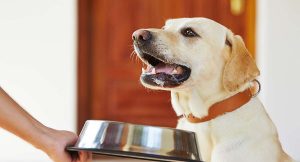
Written by Dr. Becker
From Healthy Pets
Disclaimer
The Puppy Up Foundation does not endorse nor recommend any particular product, service, or treatment. We offer information strictly for educational and/or informational purposes. We believe it is the pet owner’s responsibility to do the research and draw his or her own conclusions.
Story at-a-glance
- The pet food industry is constantly stressing the importance of fiber in dog and cat diets; however, canine and feline ancestral diets contain only minimal amounts of fiber
- The fiber sources used in processed pet food are typically inexpensive fillers such as powdered cellulose (sawdust) and dried beet pulp
- In dog and cat food, a small amount of fiber is very important, but a diet loaded with fiber is very detrimental
- Pets eating commercial raw diets may need a source of species-appropriate fiber added to their meals
The processed pet food industry continues to try to convince pet parents that dogs and cats need significant amounts of fiber in their diet.
This, of course, ignores the fact that canine and feline ancestral diets contain only minimal amounts of fiber or “roughage” (about 4 percent in the case of dogs) in the form of the hair, skin and teeth of prey animals, plus indigestible fibrous parts of plants and other odds and ends.
The popularity of grain-free diets has posed an ongoing problem for pet food manufacturers, forcing them to find alternatives to the inexpensive grains they’ve been loading up their products with for decades. As one pet food fiber ingredient supplier explains to its customers:
“As consumers demand grain-free diets, you must supplement your formulas with alternative fiber sources. This is where ingredients such as vegetable and fruit fibers, cellulose and beet pulp come in to play.”1
Of course, the reason processed pet food producers “must” use so much fiber in their formulas is because it’s plentiful and cheap. It has little to do with offering species-appropriate nutrition to dogs and cats. In the case of grain-free foods, it makes you wonder if the link between these diets and heart disease in dogs has been due in part to offsetting critical amino acids in meat with an overabundance of fiber and starch.
Fiber Sources Used in Processed Pet Food
The fiber ingredient supplier explains that fruit and vegetable fibers (which are typically byproducts — throwaways — from the human food industry) “can potentially provide added nutritional and health benefits for pets.” However, vegetable and fruit fiber is more expensive than “traditional” fiber sources used in pet food.
One of those “traditional” fiber sources is powdered cellulose, which is actually wood pulp (sawdust), primarily from pine trees. However, as the supplier points out, now that pet parents are looking for more natural ingredients in their pet’s diet, sawdust “just doesn’t fit the bill.”
In addition, powdered cellulose has a tremendous amount of insoluble fiber, and too much of it can interfere with your pet’s ability to digest and assimilate important nutrients like protein and minerals. High levels of cellulose can also rob cells in the colon of critical fuel, like butyrate, due to reduced fermentation.2 Excessive powdered cellulose in your pet’s food will also cause him to produce a bigger volume of poop.
According to the fiber supplier, beet pulp, a byproduct of sugar beets, is the second most widely used “traditional” fiber ingredient in processed pet food. Unfortunately, nearly 100 percent of all beet seeds produced in the U.S. are genetically modified, which is something else people don’t want to see in their pet’s food.
Plant Fiber Primer
Though fiber is indigestible and most types have no nutrient value, it does play an important role in the digestive process. The presence and type of fiber in the digestive tract determines how fast food passes through. Depending on the type of fiber, it can either speed up the process or slow it down.
Fiber increases bulk and water in the intestinal contents. It can slow down the rate at which food passes through the digestive tract in animals with too-fast transit times, and it can speed up the process in animals with slow transit times. That’s why fiber benefits both diarrhea and constipation.
Some fibers are also broken down in the intestine into fatty acids, which help prevent overgrowth of unfriendly bacteria. Fiber allows time for nutrients and water to pass from the large intestine into the bloodstream, and fiber also binds certain toxins in the gut and removes them from the body in feces.
Soluble fiber dissolves in water and is more digestible than insoluble fiber. Soluble fiber promotes smooth passage of food to the GI tract, while insoluble fiber speeds up the rate at which food passes through.
Soluble fiber sources include certain types of legumes, oats, rye, barley, some fruits and vegetables, root tubers, root vegetables, psyllium husk, flaxseeds and nuts. Insoluble fiber is also found in whole grain foods, wheat and corn bran, beans, peas, some nuts and seeds, as well as the skin of potatoes, lignans, green beans, cauliflower, zucchini and some fruits, including avocado, as well as the skin of some fruits, including kiwifruit and tomatoes.
Fibers are also fermentable and non-fermentable. A fiber is fermentable if the bacteria in the GI tract can break it down. Fermentable fibers contain nutrients that can be turned into energy for use by an animal’s body. Soluble fibers are generally more fermentable than insoluble fibers.
The types of fiber used most often in dry and canned pet foods include beet pulp, buckwheat and other grain hulls, flaxseed, fruit pectin, guar gum, oat and other brans, peanut shells, powdered cellulose, psyllium and tomato pomace.
Fact: Healthy Dogs and Cats Require Only Small Amounts of Species-Appropriate Fiber
When thinking about the need for fiber in your dog’s or cat’s diet, it’s important to remember that wild canines and felines have no physiologic requirement for the plant fibers used in most processed pet food.
The fiber wild dogs and cats ingest is primarily derived from the already-digested stomach contents of their prey, plus fur, tendons and ligaments, along with nibbling grasses and other plant material. Although the amount of fiber in the diet of wild dogs and cats is small (less than 5 percent in most cases), it serves a very important role.
Dogs and cats fed processed commercial diets very often benefit from the addition of a small amount of the right kind of fiber, which is fiber that closely mimics the gastrointestinal (GI) contents of small prey animals. However, when your pet consumes unnecessary fillers, like wads of fiber, it inhibits digestion and absorption of many vital nutrients.
A small amount of fiber is very important, but a diet loaded with fiber is very detrimental. If you’re feeding your dog or cat a nutritionally balanced, species-appropriate diet, which includes low-glycemic vegetables, along with appropriate supplementation, including pet probiotics and digestive enzymes, and she’s easily producing small, firm stools, she’s getting the amount of fiber she needs.
When Your Pet’s Diet Doesn’t Provide Enough Fiber
I have actually found that several brands of commercially available raw food diets are constipating for some pets. I believe this is due to the lack of fiber in the food.
Of course, opening a package of raw food to find hair, skin or guts would be totally disgusting. No one would buy such a product more than once, so I understand why raw pet food brands might be deficient in fiber content. The vast majority of balanced pet foods use low-glycemic, fibrous veggies to meet pets’ fiber needs naturally.
Veggies also provide much needed antioxidants and phytonutrients not found in meat, bones and organs. Without the benefits of veggies in raw food diets, pet run the risk of being constipated, as well.
In the wild, dogs and cats naturally choose how much grass to forage on and how much skin, hair and GI contents they consume with each prey animal they catch, but this isn’t true of pets living in our homes. This means sometimes they may need a little additional fiber for effective elimination, especially pets who are more sedentary.
If this is the case with your dog or cat, I recommend adding extra ground leafy veggies to their meals — about a teaspoon for every 10 pounds of body weight, given once or twice a day. If that isn’t effective, you can try adding psyllium husk powder at one-half teaspoon for every 10 pounds of body weight, or coconut or organic acacia fiber at 1 teaspoon for every 10 pounds of body weight, once or twice a day.
If your pet is consistently producing narrow, loose stools, he may benefit from the addition of a soluble fiber called slippery elm bark to his food. When slippery elm combines with digestive juices, it produces a gel-like material called mucilage, which coats and soothes the GI tract and helps to firm the stool. About a half a teaspoon for every 10 pounds of body weight per meal should do the trick.
Additionally, canned or freshly steamed 100 percent pumpkin can also be very beneficial for these pets. About a teaspoon of pumpkin for every 10 pounds of body weight, one to two times a day, on the food can very effectively firm a loose bowel, and keep stools very regular.
Sources and References








